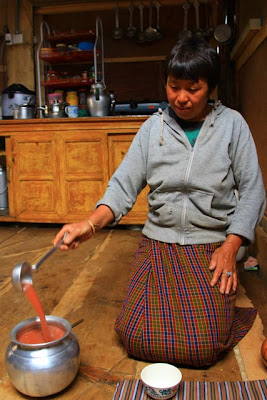Some like it hot: a chilli reception in Bhutan
 |
| Whipping up suja for breakfast on the farm. |
While the temps may be freezing on the mountains, the Bhutanese like it hot in their bowls. There's no better example than national dish, ema datse. If you need to polish your Bhutanese, ema = chilli, datse = white cheese.
"You don't come to Bhutan for the cuisine," warns an old hand before I fly over. "Just name a vegetable and add datse," jokes a local, reinforcing the theme: and thus a restaurant menu may well read: ema datse, kewa datse (potatoes & cheese) and shamu datse (mushrooms & cheese).
Take a look at the picture of ema datse, below. The green things are chillis, with the seeds left in. According to Tshering, my guide, these are the mild ones. The real hotties are tiny and bright green. Often, they're served in a small, fresh salad, esay, that comprises chopped green chillis, red onion, ginger and coriander. The chilli mix is scattered over the chilli & cheese, to add flavour.
 |
| ema datse: chilli and cheese 'stew'. |
Kids start their path down the road to hellish fire when they're about three or four. They start with the 'mild' large green chillis before working up to the little green devils, which the adults eat without working up a sweat. No wonder the Bhutanese are generally trim: they spend all their time walking mountain roads, then give the metabolism a turbo-boost with chilli served at at least two of the three main meals.
The Lonely Planet's little list of phrases at the end of the book include' Di khatshi du' ('this is too spicy') and 'Nga zhego ema dacikha miga' ('I don't like food with chillies' - hello, have these travellers no self-respect? It's like going to Iceland and saying you don't like the cold).
 |
| Farmhouse fare: dried beef and turnip stew. Chewy, but tasty. |
They're also big on local red rice, a short-grained, nutty rice, and buckwheat pancakes are a common carb as well.
Bhutan has just finished a no-meat month which sees the country's butchers shut shop and no meat on the menu, though tourist hotels are usually exempt (and the Bhutanese fill their freezers full of meat in advance, so I'm not quite sure of the benefits).
And, interestingly for the observant amongst you who were wondering about meat-eating Buddhists, they do eat meat, but they don't kill it: it's all killed in India and transported in.
 |
| I *heart* momos. |
The little landlocked country, wedged between India's northern provinces and Tibet, takes its food cues from nobody but itself, though you'll also find simply delicious momos, Tibet's little steamed dumplings of minced beef or shredded vegetables, which I last ate in Dharamsala, India, where the Dalai Lama lives in exile out of Chinese-occupied Tibet.
These ones in the photo were made in a momo specialty restaurant in Thimphu, and I also tried a larger version, which was really a knot of dough steamed and served with a blob of minced chilli and a bowl of kewa datse.
A note: despite the walking, the high-altitude and the copious amount of chillis I ate, I have not come back waif-like.


An informative, interesting and entertaining piece - but where's the fashion?
ReplyDelete